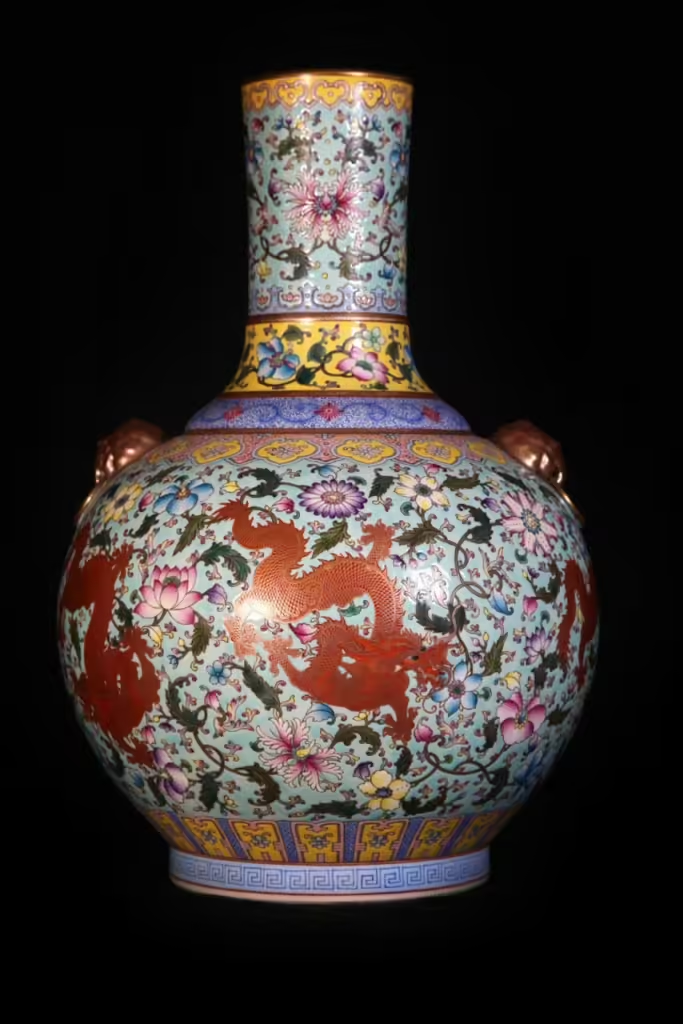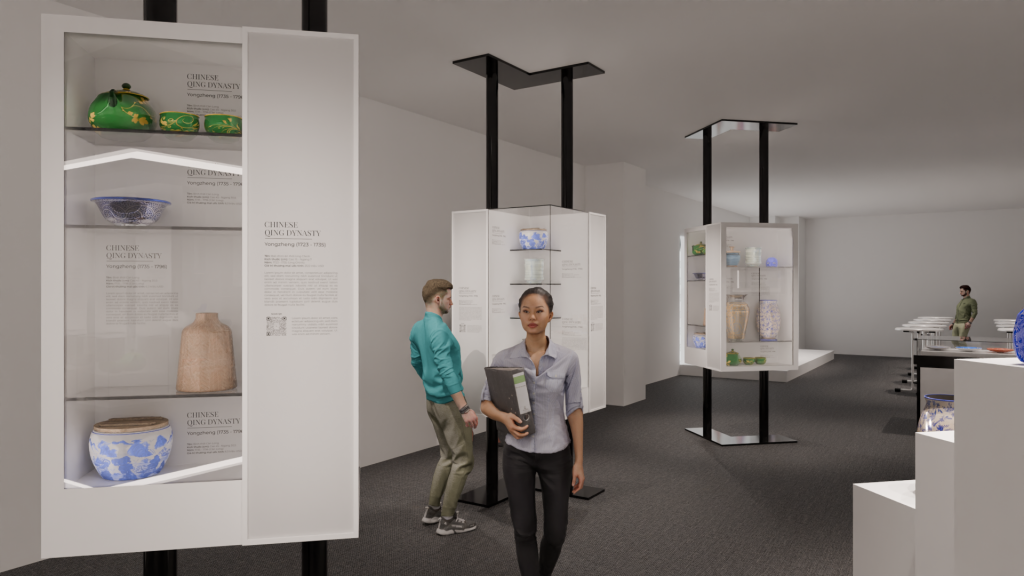Imprinted with the illustrious history of 300 years, the depth of culture, and the pinnacle of Chinese ceramic art, the artifact owned by Emperors Qianlong & Yongzheng (1723-1795) is often auctioned for tens of millions of USD at international auctions. What gives these artifacts their enduring value, making them highly sought after in the international market, inspiring endless fascination among experts and artisans for over three centuries and generations to come?
What is Katiart’s Mission? Why should readers know about Katiart’s Gallery?

I. Qing Dynasty Ceramics: The Golden Age of Chinese Ceramic Art
During the Qing Dynasty from 1644 to 1912, there were two famous ceramic production centers: Jingdezhen in Jiangxi Province and Dehua in Fujian Province. Dehua was known for producing white porcelain (Bai Ding porcelain), specializing in brush pots, tall lidded jars, and figurines of people and animals.
The pinnacle of Qing Dynasty ceramic art must be attributed to the Kangxi-Qianlong era. During Kangxi’s reign, porcelain was developed with many creative and unique shapes. During Yongzheng’s reign, a breakthrough was made with the creation of white porcelain as bright as jade, marking a significant advancement in ceramic development. The simple yet sophisticated and elegant style of Yongzheng’s era evolved into the Qianlong era, where ceramics not only featured new shapes but also adorned intricate and vibrant patterns, creating a golden age of Chinese ceramic art.
Tang Ying – The Talented Artisan Serving Two “Demanding Masters”
Tang Ying (1682 – 1756), courtesy name Jun Gong, art name Wa Ji Ju Shi, from Liaoning, Shenyang, was a famous ceramic artisan during the Qing Dynasty, serving under Emperors Yongzheng and Qianlong. Tang Ying excelled in literature, calligraphy, and painting, possessing a high level of cultural knowledge. He was both an organizer and leader of ceramic production and a researcher and developer of ceramic art. The ceramic industry in Jingdezhen during the Qing Dynasty developed rapidly, with its products gaining widespread acclaim and writing a golden chapter in the history of ancient Chinese ceramics.
A masterpiece of the Qing Dynasty was successfully auctioned for 25 million USD (Source: danviet.vn).
II. The Dragon in the Garden of Ying Cheng: A Timeless Artistic Masterpiece
The Dragon in the Garden of Ying Cheng, once owned by Emperor Yongzheng (1723-1735), stands 45cm tall and 31cm wide.
With its distinctive shape and intricate patterns, adorned with majestic animal heads on both sides, this ancient ceramic vase with its vibrant and unique floral motifs not only represents the prosperity and power of a dynasty but also praises the talent of ancient artisans – “The artists who painted the soul of ancient vases.”
The motifs on the Dragon in the Garden of Ying Cheng bear the distinct mark of Eastern culture.
The vase, with its dominant jade green color, creates a harmonious and refreshing appearance. The impressive and meticulous brushwork, especially the highly intricate and delicate dotting technique, combined with the jade green background, gives the patterns a three-dimensional space, as if the dragon is flying among the flowers swaying in the wind. Looking at the vase, one not only sees the unique patterns drawn by the skilled hands of the artisan but also the image of a prosperous, luxurious dynasty placed right in the majestic palace of the Forbidden City.
- Dragon: The red dragon flying among the flowers, in Eastern culture, is a mythical creature symbolizing supreme power, with unparalleled strength, ruling over all beings. Therefore, the dragon motif always appears on items exclusively for ancient kings. If observed closely, one can see the extraordinary talent of the artisan in painting the golden dragon scales, with fine lines requiring skill and meticulousness. The impressive breakthrough in Yongzheng ceramics is the brilliant elevation of colors, evident in the vase with many patterns depicted from various flowers, symbolizing good fortune.
- Floral Garden: The image of the dragon flying among a sky full of fragrant flowers opens up a painting of a prosperous, colorful landscape, where each flower carries a meaning of good luck, fortune, and longevity.
An impressive aspect is the supreme creativity of the monarchs in combining lotus and plum blossoms, with the lotus long renowned for its pure, pristine beauty, harmonizing with the prosperity and luck of the plum blossom.
The image of the vines stretching out further showcases the deep and meticulous thoughts of ancient artisans, with the vines gracefully extending across the vase, tightly interwoven to form a solid network, extending endlessly, as a blessing for a prosperous, enduring, and wealthy dynasty.
- Imperial Seal (at the bottom of the vase): “Yongzheng Nian Zhi” proves that the Dragon in the Garden of Ying Cheng was crafted and once owned by Emperor Yongzheng.
Learn more about the knowledge provided by Katiart’s Gallery?
The vase was crafted by the skilled hands of Tang Ying, a master of Qing Dynasty ceramic techniques. He served as the overseer of the royal Jingdezhen kiln for 20 years, serving under Emperors Yongzheng and Qianlong. Proficient in literature, calligraphy, and painting, and possessing a refined demeanor, this artisan created many intricate and meaningful ceramic works, beloved by successive emperors.
A similar vase once owned by Emperor Qianlong was sold for over 6.3 million USD (equivalent to 144 billion VND) at Christie’s Hong Kong auction house.
III. Chinese Antiquities: Witnesses of History and Culture Appearing for the First Time in Vietnam
The Dragon in the Garden of Ying Cheng is not only a masterpiece of high ceramic art but also a testament to the talent and creative spirit of Qing Dynasty ceramic artisans. The vase is an invaluable Chinese antique, carrying profound historical and cultural values – recognized by the art elite and embraced by the public who love culture and art for hundreds of years.
Museums & art galleries around the world are places to preserve and display precious Chinese antiques:
- Katiart’s Gallery – Vietnam
- National Palace Museum – Taipei
- The Metropolitan Museum of Art – New York
- Victoria and Albert Museum (V&A) – London
- Musée Guimet – Paris

Katiart’s Gallery not only honors the value of each artifact but also evokes historical stories and human mysteries, inspiring future generations, opening the door to the wonderful world of knowledge and creativity.
The exhibition “Katiart’s – The Essence of Ceramics” is a journey through history, honoring the essence of traditional craftsmanship, from ancient times to the modern era. The displayed works not only carry material value but also embody the culture and soul of humanity through the ages. The exhibition is not only a place to admire the beauty of creations but also a bridge to the past, preserving the mysteries and exquisite techniques passed down through generations.
Related Articles:
